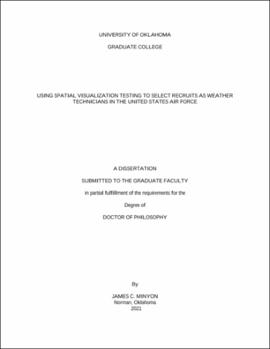| dc.description.abstract | This study reviews the current qualities and requirements that the United States Air Force (USAF) uses to select its enlisted weather forecasters. Specifically, I will focus on spatial visualization skills and researching their application on personnel taking the Armed Services Vocational Aptitude Battery (ASVAB) test for selection to enlist in the USAF as a Weather (Meteorological) Technician.
Recent research “suggests that spatial abilities may be an important predictor of performance, particularly in scientific and technical fields” (National Research Council of the National Academies, 2015). This study is concentrated on uncovering antecedents that may assist during the process of selecting personnel for AF Weather (AFW). The premise of this research is to find out if spatial visualization tests could be used as predictors of performance for AFW technicians. The utilization of spatial visualization testing could be especially important in a projected future competitive recruiting environment by providing assistance in identifying the right recruits who can succeed in the AFW career field.
During operations, meteorologists can become too reliant on weather forecast models. On occasion, there are periods when model data is inaccurate (off) or not available due to computer outages (both deliberate and undeliberate). There may also be instances where a person cannot access weather model data, for example, during a power outage. It is during these critical situations that meteorologists must be able to use their mental models and spatial visualization skills to assist in determining a forecast of what the weather will do when the model is off, inaccurate, or unavailable.
Additionally, in a world where cyber-attacks are becoming more common—in both military and commercial industry website enclaves—the likelihood that weather data availability and data reliability may be questionable at times in the future will also increase. As a consequence, USAF Weather Technicians (forecasters) can become over-confident and over reliant when it comes to their expectation of data flow and communication capabilities via the internet by assuming that weather data will always be available and always be accurate. Lack of or manipulation of this data would also require the use of spatial visualization skills to predict the weather of the future and its impacts on USAF missions.
Currently, the ASVAB includes a spatial-visualization test battery known as Assembling Objects (AO) that all candidates must take. However, this score is not used as a selection determinant for classifying someone to enter the USAF in the scientific Weather Technician specialty. Additionally, the Santa Barbara Sense of Direction (SBSOD) survey, developed by Hegarty, also considers spatial visualization skills as being an important factor in the natural science fields (Hegarty, Crookes, & Shipley, 2010). I posit that utilizing spatial visualization testing, like the ASVAB AO score and the SBSOD, would be advantageous for the USAF to use as selection determinants for future Weather Technicians.
It is imperative that the USAF select the right people (those with spatial visualization skills) for the right jobs (the Weather Technician specialty) at the right time to ensure future mission success. Examining the use of the AO test battery from the ASVAB and the Santa Barbara Sense of Direction survey to assist in determining spatial visualization capabilities could go a long way in supporting the endeavor of selecting the right people to become weather-recruits for the USAF. | en_US |
